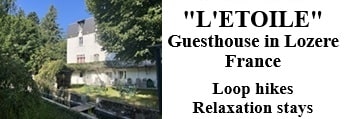4km hike in La Bastide-Puylaurent |
At the beginning of the 16th century, La Bastide was a hamlet of seven or eight houses located on the right bank of the Allier River. In the Gevaudan area stood the farm inhabited for several centuries by the Bastide family (who, for some, gave their name to the village) and which will also be called "Trouillas." It served as a farm-inn for pilgrims, merchants, and transhumants who followed the Regordane route. The arrival of the railway in 1870, followed by the establishment of the Notre-Dame-des-Neiges monastery a few years later, as well as the emergence of the Saint-Laurent-les-Bains thermal spa, greatly contributed to the development of the village.

4km - 11km - 11,2km - 14km - 15,5km - 16,3km - 19km - 21,5km - 23,2km - 24km








Distance: 4 km, Maximum altitude: 1,086 m, Minimum altitude: 1,015 m, Total elevation gain: 75 m
IGN Maps: La Bastide-Puylaurent (2738E). Largentiere La Bastide-Puylaurent Vivarais Cevenol (2838OT)
La Bastide-Puylaurent, a commune in Lozere in the Occitanie region, is a village of around 170 inhabitants located in the heart of the Cevennes National Park. This place, marked by a rich natural and historical heritage, attracts nature and hiking enthusiasts thanks to its mountains, forests and rivers. The village is crossed by several long-distance hiking trails, including the famous GR70, or Stevenson Trail, and the Voie Regordane, which links Le Puy-en-Velay to Ales. Its development was driven by the construction of the station in the 19th century, which made it an important railway stop between Lozere and Ardeche. Today, it remains the highest station on the line linking Paris to Marseille via Clermont-Ferrand. Several shops and accommodation are available there, facilitating the reception of hikers and visitors, who also benefit from numerous leisure options, such as camping near the Allier and swimming areas. The cultural heritage is also notable, notably with the Pont de la Resistance, built during the Second World War, and the proximity of the Cistercian abbey Notre Dame des Neiges, a place of meditation. The ancient history of the village also reveals the importance of a welcoming activity for travelers from the 18th century with relays for pilgrims and muleteers. Located at the crossroads of the Cevennes and Vivarais, La Bastide-Puylaurent offers an exceptional panorama of the surrounding high plateaus, with clear views of the mountains and landscapes testifying to the Cevennes rurality. This natural and preserved setting continues to seduce those who seek both tranquility, discovery of heritage and immersion in the typical landscapes of the Cevennes.
La Bastide-Puylaurent is a village rich in history, anchored in both the gentleness and the harshness of the mountains. Originally, the seat of the commune was in Puylaurent, a hamlet perched above the Allier valley, but in 1917 it was transferred to La Bastide, marking the beginning of a new era for the village. The history of this place goes back to the 16th century, when La Bastide was just a small group of houses on the banks of the Allier, surrounded by land occupied by influential families and crossed by the historic Regordane road, used by traders and pilgrims. The village has also been marked by political and religious events. In the 18th century, it housed a chapel and a pilgrims' hospital, testifying to the work of the monks of Tornac. Later, during the French Revolution, La Bastide-Puylaurent became the scene of the royalist conspiracy of the Count of Saillans, who attempted to overthrow the republican regime, before being repressed by republican troops. In 1940, while Europe was at war, La Bastide-Puylaurent became a refuge for Poles fleeing Nazi and Soviet persecution. A reception center, run by Zbigniew Malinowski and supported by the Red Cross, offered the refugees care, education and invaluable solidarity. Despite persecution by the Vichy police and the German occupation in 1944, the center embodied a symbol of fraternity between peoples and resistance to oppression.
The Chemin de Regordane, now marked as the GR®700, is an ancient passageway with a rich and varied heritage, crossing unique natural landscapes and historically connecting the north of France to the Mediterranean. Originating from geological movements, the natural route of this fault was first used by animals, followed later by humans who transformed the track into a draille, and later into a trade and strategic route. The Romans used it for the metal trade, but it gained in importance in the Middle Ages when trade developed between the Kingdom of France and the German Empire. Infrastructure was built, and the road became an essential traffic axis for convoys of goods, with warehouses and dwellings, some of the remains of which still exist. This road also had a religious dimension, welcoming pilgrims on their way to Saint-Gilles, a major pilgrimage centre and departure point for Jerusalem and Rome. Its commercial importance declined with the wars and the plague in the 14th century, and the road fell asleep until the 17th century, when redevelopment work brought it back to life under royal impetus. In the 18th century, a new road was built to facilitate the passage of stagecoaches, but its intensive use diminished with the advent of the railway, leaving it to gradually fade away. Today, the Chemin de Regordane is an invitation to rediscover an ancient history. This path, with its paving stones, changing landscapes and architectural remains, recalls its prestigious past where traders, pilgrims, knights and troubadours crossed paths.
